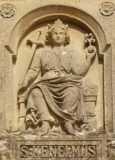
This site provides details of two long distances walks, both themed around the legend of St Kenelm. The two walks, The St Kenelm’s Trail and The St Kenelm’s Way, each take 4-6 days and link the Clent Hills, South of Birmingham with Winchcombe, north of Cheltenham.
Saint Kenelm himself is one of the most important Saints of medieval England, one referred to in the Canterbury Tales and venerated throughout England. His legend identifies him as a member of the royal family of Mercia, a Boy-King and martyr, murdered in the Clent Hills to further the interests of an ambitious relative. After his body was concealed, it supposedly came to light by virtue of miraculous intervention and was transported to Winchcombe, which became a major shrine where Kenelm was venerated for several hundred years.
The two walks link the places commonly associated with Kenelm’s legend and recall the journey recorded as being taken by the monks with the Saint’s remains. It is a journey across many memorable landscapes, visiting numerous ancient villages, and the picturesque, historic yet obscure Huddington Court and conclude with a spectacular finish passing by the ruins of Hailes Abbey and through the grounds of the famous Sudeley Castle.

If the legend of St Kenelm is the central idea of the two walks that are the subject of this website, I would suggest that a broader unifying theme is the religious life of Medieval England. As many as ten churches dating from the Middle Ages can be found on the routes; in addition, there are two holy wells associated with Kenelm and two ruined monasteries (Winchcombe and Hailes Abbey), which were also important pilgrim sites. If we also consider the famous monasteries that lie near the route at Halesowen, Worcester, Evesham, Pershore and Tewkesbury it can be seen that the area covered by the walks has a rich and ancient religious tradition. Not surprisingly perhaps, this area figured prominently in opposition to the Reformation with many nearby manor houses being associated with the Gunpowder Plot; in particular Coughton Court, Hagley Hall and Hewell Grange, all of which lie near the walks and Huddingdon Court which is actually on them.
The walks also recalls the Old Religion of England because it invites the participant to escape from urban life and glimpse the rural world of seasonal birth, death and regeneration which formed the reality of daily existence of Medieval England and which were rendered meaningful by the cycle of liturgical and sacramental celebrations of the churches we still see today. In this context, we can begin to understand how the story of the murder and sanctification of a Boy-King offered hope of renewal and why it held such a hold on the collective imagination of the period. It is also something to contemplate as we view the fascinating trail of religious monuments present on this route.
My personal motivation for creating and promoting The St Kenelm Trail is closely connected with a deep interest in the history and practice of pilgrimage. The British Pilgrimage Trust has done an enormous amount to promote interest in the subject, and they have identified the St Kenelm walks as major routes in Worcestershire and Gloucestershire. This is their webpage that deals with them:
The aim of this site is to provide help with the walk and background about the theme. It features interactive maps of the routes, which can be downloaded in gpx format and detailed accounts of the legend and memorials of the Saint. Also, there are videos of St Kenelm’s Trail and a performance of a musical setting of The Ballad of St Kenelm. I hope you enjoy it.
John Price – jp@kenelmwalks.uk
February 2022

